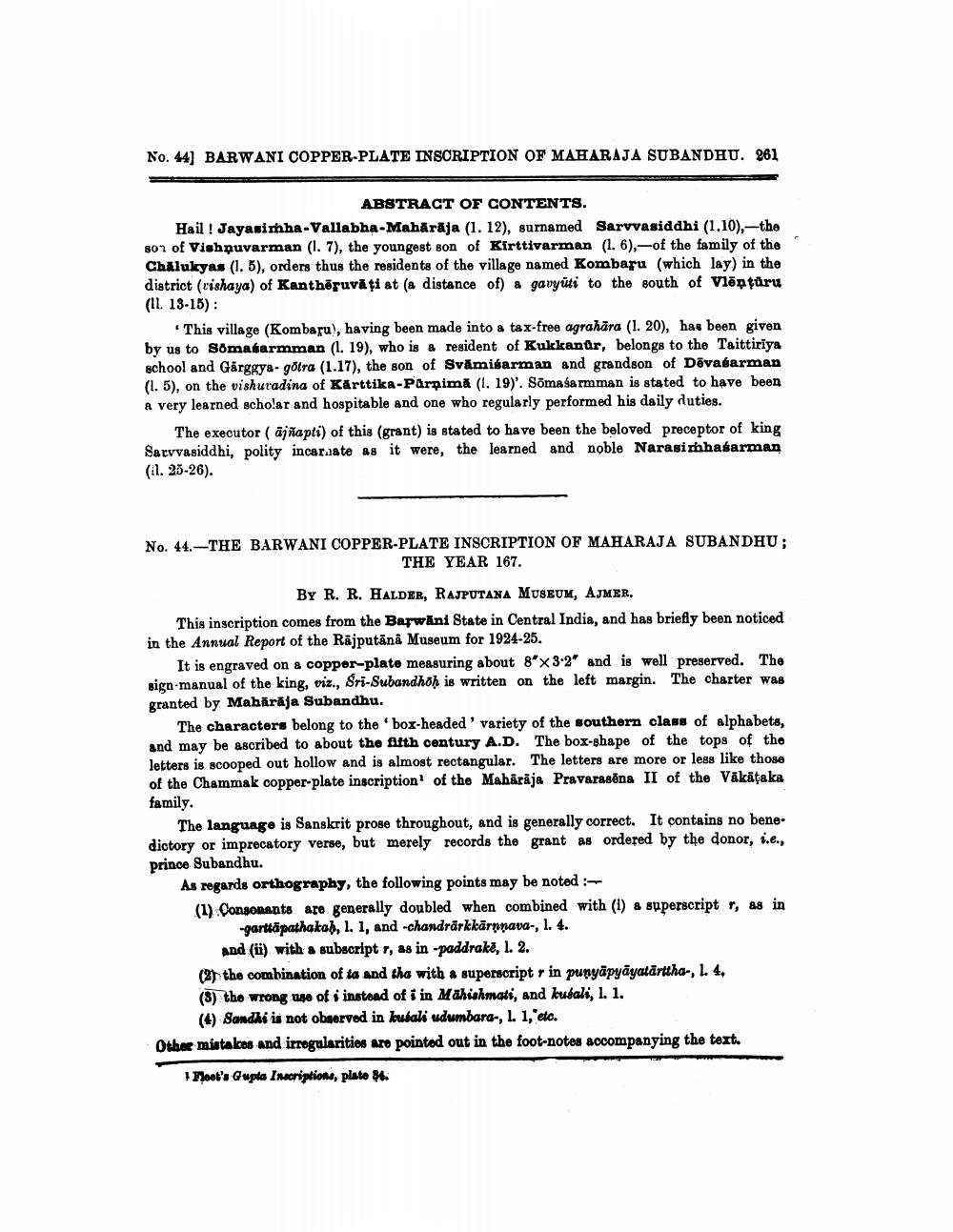________________
No. 44) BARWANI COPPER-PLATE INSCRIPTION OF MAHARAJA SUBANDHU. 261
ABSTRACT OF CONTENTS. Hail ! Jayasimha-Vallabha-Maharaja (1. 12), surnamed Sarvvasiddhi (1.10).-the 807 of Vishnuvarman (1. 7), the youngest son of Kirttivarman (1. 6), -of the family of the Chalukyas (1.5), orders thus the residents of the village named Kombaru (which lay) in the district (vishaya) of Kanthöruvāti at a distance of) a gavyüti to the south of Vlēpturu (IL. 13-15):
This village (Kombaru), having been made into a tax-free agrahāra (1. 20), has been given by us to Somasarmman (1. 19), who is a resident of Kukkanür, belongs to the Taittiriya school and Gárggya- götra (1.17), the son of Svāmisarman and grandson of Dēvasarman (1. 5), on the vishuradina of Kärttika-Parnimā (1. 19)'. Sömaśarmman is stated to have been a very learned scholar and hospitable and one who regularly performed his daily duties.
The executor (ājñapti) of this (grant) is stated to have been the beloved preceptor of king Sarvvasiddhi, polity incarnate as it were, the learned and noble Narasimhasarman (il. 25-26).
No. 44.-THE BARWANI COPPER-PLATE INSCRIPTION OF MAHARAJA SUBANDHU ;
THE YEAR 167.
BY R. R. HALDER, RAJPUTANA MUSEUM, AJMER. This inscription comes from the Barwāni State in Central India, and has briefly been noticed in the Annual Report of the Rājputāna Museum for 1924-25.
It is engraved on a copper-plate measuring about 8" x 3.2" and is well preserved. The sign-manual of the king, viz., Sri-Subandhoh is written on the left margin. The charter was granted by Mahārāja Subandhu.
The characters belong to the box-headed' variety of the southern class of alphabets, and may be ascribed to about the Afth century A.D. The box-shape of the tops of the letters is scooped out hollow and is almost rectangular. The letters are more or less like those of the Chammak copper-plate inscription of the Maharaja Pravarasēna II of the Väkätaka family.
The language is Sanskrit prose throughout, and is generally correct. It contains no benedictory or imprecatory verse, but merely records the grant as ordered by the donor, i.e., prince Subandhu.
As regards orthography, the following points may be noted : (1) Consonants are generally doubled when combined with (1) a superscript r, as in
-garttapathaka), l. 1, and -chandrärkkārnnava-, 1. 4. and (ii) with a subscript , as in .paddrake, 1. 2. (2) the combination of ta and tha with a superscript r in punyāpyāyatarttha-, l. 4. (3) the wrong use of i instead of i in Mahishmati, and kubali, 1. 1.
(4) Sandhi is not observed in kubali udumbara-, L. 1,eto. Othar mistakes and irregularities are pointed out in the foot-notes accompanying the text.
Foot's Gupta Inscriptions, plate Phi




